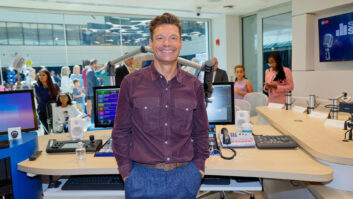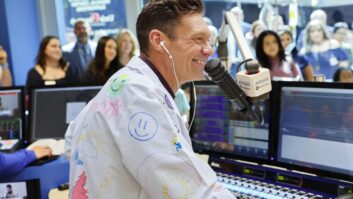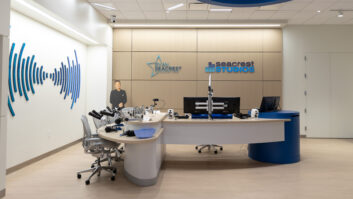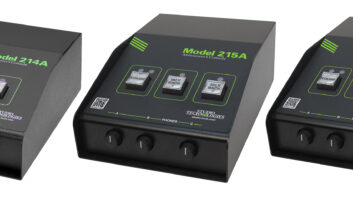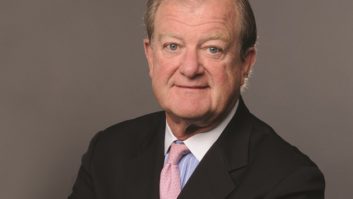
When I began my career of making studios work I never imagined some of the places it would take me. From senior staff positions at high-profile Hollywood recording studios, to major-market radio broadcast facilities to leading pediatric hospitals around the country.
The hospitals have been proud recipients of their very own Seacrest Studios multimedia production facilities, donated by the Ryan Seacrest Foundation.
The most recent opened in March in the Monroe Carrell Jr. Children’s Hospital at Vanderbilt University in Nashville, Tenn. The grand opening ceremony featured speeches from benefactor Ryan Seacrest, hospital administrators and Mr. Seacrest’s secret special guest, Taylor Swift. After the ribbon was cut, he kicked off the new studio with an interview and live music show, then spent the rest of the day visiting with patients.
INVOLVEMENT
Seacrest Studios are radio and TV broadcast facilities built inside and run by pediatric hospitals. Shows are broadcast on the hospital’s TV system and sometimes to other Seacrest Studio locations via a Polycom video conference system.
The studios center around a custom and shapely Omnirax broadcast desk. The show host stands at the mixing board to run things. Across the desk there are five seated guest positions. Patients, their family members and others are invited to join the show host and sometimes celebrity guests, to put on a live radio show with a TV simulcast. Patients that cannot make it into the studio can still call in from their rooms to participate.
I became involved with the Ryan Seacrest Foundation through my relationship with Director of Engineering Brian Clark. For many years he has used my studio integration company, Immaculate Connections Inc., on facility builds such as Radio Disney in Burbank, Calif., and the Los Angeles Angels radio station at their stadium in Anaheim, Calif.
In January of 2013 he recommended the foundation hire us to do the broadcast integration for Seacrest Studios at Children’s Hospital of Orange County in California. Since then, we have done five more of the facilities: Levine Children’s Hospital in Charlotte, N.C., Children’s Hospital Colorado in Denver, Boston Children’s Hospital, Children’s National Medical Center in Washington, and now the Nashville studio.
Seacrest Studios Nashville Manager Mamie Shepherd served as the original studio manager at the Charlotte hospital for two years before moving to Nashville to manage the new facility. She believes that “Seacrest Studios has signaled an awakening in the way events, activities and some therapies are handled at children’s hospitals across the country.”
“Parents routinely thank us for what the Ryan Seacrest Foundation has provided. Seacrest Studios can be one part reality, one part fantasy. It’s a place for a kid to dream, plan, grow, learn, sing openly and just be a kid again — not a diagnosis. The generosity of the foundation, has given sick and injured children across the United States a place to be cool.”
PARTICIPATION
My participation in a new Seacrest Studio begins on conference calls and email exchanges with local hospital staff and construction officials. Questions are asked and answered in both directions. Early on I send a list of the studio’s requirements so they can be ordered in advance.
Since these studios are located inside hospitals, strict compliance with Health Insurance Portability and Accountability Act Privacy Rule Standards must be maintained. All hospital network traffic is highly monitored and controlled.
This creates a problem for engineers and equipment manufacturers who need to remote-in to configure and maintain equipment. Special provisions have to be set in place to allow this type of remote access without endangering patient medical records. Once in place the automation system music can be updated regularly and the mixing console can be reconfigured as changes come along.
For most of these builds I travel to the sites by myself, having shipped my tools and materials in advance. Ideally, I arrive after most of the construction trades are done, but this happens only half the time. I also hope that all work to be performed in the ceilings is complete and that they are closed. When ceiling tiles are not in place, it is always raining dust particles into the room, no matter how loud your HEPA filter is.
Soon after arrival, I meet with the electricians and data cabling people to advise on outlet and jack locations inside the studio furniture and on air warning sign locations and control. I also confer with the A/V contractors on the overall goals of the systems.
It takes about 18 days to complete the broadcast audio integration of the studio. I receive lots of help from the local crews and staff with things like cable pulls, equipment delivery and heavy lifting. We always have in mind the fact that a hard deadline is speeding in our direction and there’s a lot to get right and reliable before that time arrives.
EQUIPMENT
Seacrest Studios all utilize the same equipment, originally specified by Clark, with some adaptations and changes from time to time. Audio and control center on a Sierra Automated Systems Rio Link mix engine and iSL mix surface from the same company. Automation comes from a Broadcast Software International Op-X automation system.
Equipment includes a 360 Systems Instant Replay and a Wheatstone VoxPro recorder/editor. A Comrex STAC telephone hybrid takes calls on six lines and a Telos Zephyr Xtreme codec is used for remote connection. The microphones are processed though a Symetrix Jupiter 8 and are mounted on low-profile Yellowtec mika! On Air mic arms.
On the video side, there are two high-definition remote control cameras mounted in strategic locations and processed through a NewTek TriCaster unit. The TriCaster is also used for video production. A rack full of Crestron and Extron equipment handles the video switching, scaling and distribution. And a green screen rolls down out of the ceiling for all kinds of video production.
Of unexpected benefit are intern programs. Interns are recruited from local colleges to assist in all capacities. Shepherd notes that “While interning for RSF, college students from across the country gain valuable experience working radio boards, operating video cameras and editing footage from celebrity visits. That is the technical side. Interns also get hands-on experience behind the microphone when they interview guests who make appearances in the studio. We give students a place to bring what they are learning in college to a working broadcast media center.”
The foundation continues to work toward its goal of building Seacrest Studios, contributing to the healing process of children and their families. It has been my privilege to work with this fine organization and to see the miraculous work performed every day at the hospitals we work in.
For information on the Ryan Seacrest Foundation, browse to ryanseacrestfoundation.org. Radio World’s 2011 special report on the early days of the project is available at www.radioworld.com/supplements.
Mitch Robertson is chief engineer for Immaculate Connections Inc. in Tarzana, Calif.





